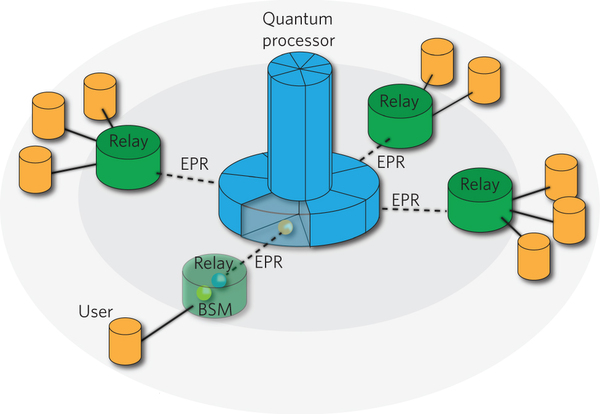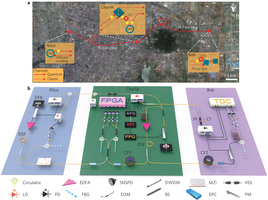

Quantum teleportation transfers a quantum state between distant nodes in a network, which enables revolutionary information-processing applications. This has motivated a tremendous amount of research activity. However, in the past not a single quantum-teleportation experiment has been realized with independent quantum sources, entanglement distribution prior to the Bell-state measurement (BSM) and feedforward operation simultaneously , even in a laboratory environment. Professor Pan Jianwei’s research group at the University of Science and Technology of China (UTSC) in collaboration with Tsinghua University took the challenge and reports the construction of a 30 km optical-fiber-based quantum network distributed over a 12.5 km area, realized by using a superconducting nanowire single photon detector developed by the Shanghai Institute of Microsystem and Information Technology, Chinese Academy of Sciences (CAS).

This network is robust against noise in the real world with active stabilization strategies, which allows us to realize quantum teleportation with all the ingredients simultaneously. Both the quantum-state and process-tomography measurements and an independent statistical hypothesis test confirm the quantum nature of the quantum teleportation over this network. Their experiment marks a critical step towards the realization of a global ‘quantum internet’ in the real world.
Quantum entanglement is at the heart of quantum mechanics. Bennett et al. found that quantum entanglement is the key to realizing the dream of teleportation. Quantum teleportation transfers the quantum state of a physical system, instead of the system itself, between distant nodes, which underlies the proposals of distributed quantum computing and quantum-communication networks.
Figure 1 depicts a future quantum network. The central node hosts a quantum processor. It shares entanglement with many relay nodes, which constitute a star-topology structure. The end user accesses the central quantum processor by teleporting the quantum state to the central node via the nearby relay nodes. The relay nodes perform an entanglement distribution and BSM, and feedforward the measurement outcomes to the central processor. The structure may be replicated to form a larger network. The quantum network with distant nodes demands that each node has an independent quantum source. Therefore, a critical step in the roadmap towards realizing a global quantum network is to implement independent quantum sources, prior entanglement distribution and active feedforward operation simultaneously in a single experimental demonstration of quantum teleportation in the real world. This remains an experimental challenge because it requires the interference of independent photons as flying qubits from distant nodes in a quantum network with a high and stable quantum-interference visibility. To do that, one can eliminate the spectral and spatial distinguishability by applying spectral and spatial filtering. However, the real challenge is that the fluctuation of the effective length of the quantum channel in the real world makes independent photons distinguishable at interference, which was not a concern in previous experiments that were performed locally in a stable laboratory environment.

To overcome the challenge, the group developed a number of experimental techniques to stabilize the quantum channel; in particular, they used the error signal derived from the photon arrival time in the feedback loop to reduce the overall time jitter between independent photons of distant nodes to 6 ps, which is insignificant compared with the 110 ps coherence time of photons. As such, the quantum interference between independent photons from distant nodes in their system is robust for all degrees of freedom and the experiment runs continuously with high state fidelity for weeks without maintenance.
To meet the requirement of prior entanglement distribution, they buffered EPR (Einstein, Podolsky, Rosen) photons in coiled optical fiber at both the relay node and the central node after entanglement distribution. This allowed them to perform the BSM after the single photons arrived at the relay node and to forward the BSM outcomes in real time to the central node to do unitary transformation. Their quantum-teleportation experiment over a realistic network with independent quantum sources, prior entanglement distribution and active feedforward operation marks a critical step in the roadmap towards realizing a global quantum network.
The network is deployed in the city of Hefei, China. As shown in Figure. 2a, Charlie (N 31° 51′ 5.42″, E 117° 11′ 55.82″) is the relay, Alice (N 31° 50′ 7.50″, E 117° 15′ 50.56″) is the user and Bob (N 31° 50′ 11.42″, E 117° 7′ 54.37″) is the central processor. Alice (Bob) is connected to Charlie with a 15.7 km (14.7 km) single-mode optical fiber with a propagation loss of 5 dB (6 dB).
The long coherence time of the prepared quantum state allowed them to synchronize independent quantum sources that were far apart with off-the-shelf instruments. They kept a master clock at the node of Charlie and used it to trigger a pulse-pattern generator (PPG). The PPG drove the electro-optic modulator (EOM) to carve the continuous wave (CW) laser beam periodically into 75 ps pulses, separated by 10 ns. These pulses were used to create the EPR pairs for Charlie after amplification. A fraction of each of these optical pulses was sent to Alice's side, where it was detected by a 45 GHz photodetector (PD). The photodetection signal was used to trigger the creation of Alice's quantum source. Although the quantum sources and BSM were within the same laboratory in previous experiments, in their field test the single photons needed to travel through a fiber from Alice to Charlie, separated by 6.5 km in the field. The ambient temperature can change by more than 10 °C over 24 hours. As a result, the effective length and polarization property of the fiber changed significantly, which can make the photons from separate sources distinguishable. They fed back the error signal derived from the photon-arrival time to the variable delay line (VDL) to control the creation of independent quantum sources. By reducing the time jitter between independent photons to 6 ps, they largely suppressed the distinguishability. The change in fiber-polarization property can change the photon count rate by more than 100 percent in 70 hours of continuous measurement, which was reduced to three percent by using a separate feedback loop. It is evident that this method can be used to synchronize many nodes of a quantum network.
Lastly, they examined the possibility of any classical process producing the results observed in their field test.
By applying a variety of feedback mechanisms to suppress the noise in wavelength, time, spectrum, phase, polarization and power, they realized a robust quantum-teleportation system in the real world. Their experiment, along with two recent field tests of quantum teleportation, may serve as the benchmark to realize quantum teleportation in the real world. The developed technology is immediately applicable to a wide array of quantum information-processing applications with independent quantum sources.
Their achievement was published online by Nature Photonics of Nature on September 19, 2016.